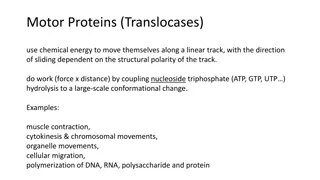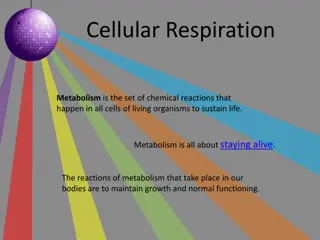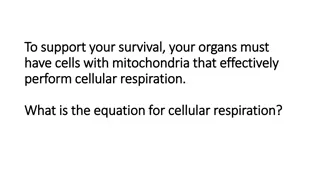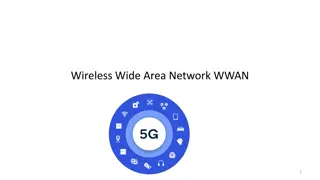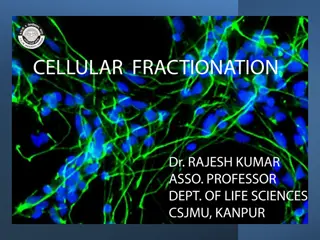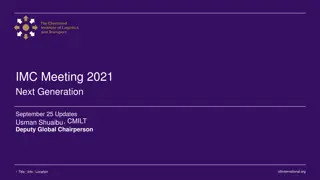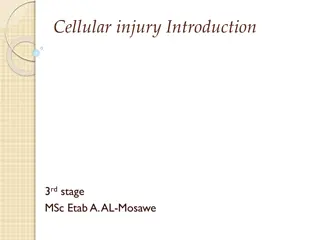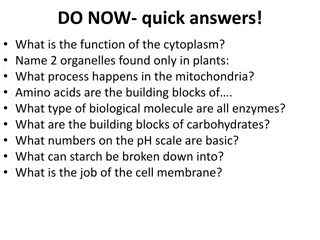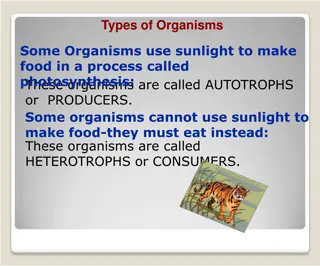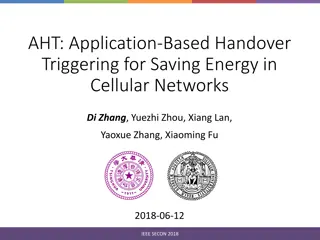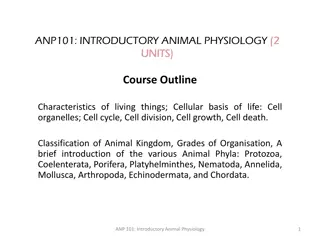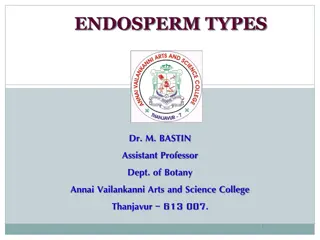Evolution of Wi-Fi and Cellular Technologies for Next Generation
The document discusses the initiation of a new study group for the next generation of Wi-Fi following IEEE 802.11be, emphasizing objectives like deterministic operation, increased throughput, and capacity. It outlines a timeline for the launch of new mainstream PHY/MAC generations every four years. Additionally, it highlights the high-level objectives for 6G cellular technology standardization starting in 3GPP Release 20 with a focus on enhancing key performance indicators like throughput, latency, spectral efficiency, and energy efficiency.
Download Presentation

Please find below an Image/Link to download the presentation.
The content on the website is provided AS IS for your information and personal use only. It may not be sold, licensed, or shared on other websites without obtaining consent from the author.If you encounter any issues during the download, it is possible that the publisher has removed the file from their server.
You are allowed to download the files provided on this website for personal or commercial use, subject to the condition that they are used lawfully. All files are the property of their respective owners.
The content on the website is provided AS IS for your information and personal use only. It may not be sold, licensed, or shared on other websites without obtaining consent from the author.
E N D
Presentation Transcript
Doc.: IEEE 802.11-22/0046r1 Jan 2022 Next 802.11 generation after 11be Date: 2022-01-11 Authors: Name Affiliation Address Phone Email 2111 NE 25th Ave, Hillsboro OR 97124, USA Laurent Cariou laurent.cariou@intel.com +1-503-712- 5560 Robert Stacey robert.stacey@intel.com Intel Carlos Cordeiro carlos.cordeiro@intel.com Submission Slide 1 Laurent Cariou, Intel
Doc.: IEEE 802.11-22/0046r1 Jan 2022 Key messages It is time to start a new study group for next generation Wi-Fi, following 802.11be The goals of this project should be focused on multiple objectives to be competitive and address future market needs/evolution Continue pursuing deterministic operation (e.g., in terms of worst-case latency at a given reliability) Continue increasing throughput and capacity Submission Slide 2 Laurent Cariou, Intel
Doc.: IEEE 802.11-22/0046r1 Jan 2022 Content Timeline Motivation and rationale for the proposed scope/objectives for next generation Wi-Fi Submission Slide 3 Laurent Cariou, Intel
Doc.: IEEE 802.11-22/0046r1 Jan 2022 Timeline As mentioned before (see 1598r1), the Wi-Fi market is moving to a 4 years cadence for the launch of new mainstream PHY/MAC generations Meaning a new task group every 4 years Following this approach, we would have: 11be R1 products around end of 2023 11be R2 products around end of 2025 11bX (next gen) R1 products around end of 2027 Submission
Doc.: IEEE 802.11-22/0046r1 Jan 2022 IEEE 802.11bX Timeline TGbe TGbX Mar 2019: PAR approved Mar 2023: PAR approved May 2019: First TG meeting May 2023: First TG meeting May 2021: D1.0 May 2025: D1.0 Mar 2022: D2.0 Mar 2026: D2.0 Nov 2022: D3.0 Nov 2026: D3.0 Mar 2024: Final 802.11 WG approval Mar 2028: Final 802.11 WG approval Implications for TGbX: - if we have a year-long SG, TGbX should be created around July 2022 - As discussed in 11be, we are thinking about a light 11be R2 and to move undefined agreed 11be R2 features to TGbX (see 1598r1): Multi-AP coordination features Submission
Doc.: IEEE 802.11-22/0046r1 Jan 2022 High-level next gen cellular (6G) objectives Plan to start standardization with release 20 in 3GPP 2025: end of study item phase 2028: end of work item phase 2 years to reach product launch: first products planned for 2030 This would be roughly 2 years after estimated time of next gen .11 if we follow plan in previous slides Wi-Fi needs to be competitive and ambitious with regards to 6G objectives 6G aims to improve multiple KPIs, for example: 10x throughput 0.1ms latency spectral efficiency Spatial reuse - area efficiency Energy efficiency Note that, similarly to what happened for 5G, these objectives will be reached with a combination of lower bands as well as mmWave (and possibly Terahertz) Submission
Doc.: IEEE 802.11-22/0046r1 Jan 2022 Some trends that we see for 2028-2030 timeframe (1) Deterministic operation Applications like XR will become a key driver and are expected to become mainstream in few years in multiple/most deployment scenarios setting stringent requirements for deterministic low latency and throughput Some of these applications/devices are targeting usage in mobile scenarios (glasses for instance) with very stringent low latency needs: This also calls for improved lossless and seamless mobility within an ESS in a house/enterprise TSN networks Cloud/edge computing also requires low and predictable latency Aim for improved deterministic operation (e.g., worst-case latency at given reliability, 0.1ms latency) Submission Slide 7 Intel
Doc.: IEEE 802.11-22/0046r1 Jan 2022 Some trends that we see for 2028-2030 timeframe (2) Toward 10Gig Wi-Fi As usual, the need for more throughput/data rate is in constant evolution Projections from Fiber Broadband Association predicts that in 2030, household will need more than 2Gbps of broadband by 2030 (a x16 increase compared to 2021 (130Mbps)) Some projections showing even up to 30Gbps demand for broadband Need increase throughput and throughput at range on Wi-Fi to efficiently deliver this to the entire house 10G: cablelabs-launches-10g-challenge-support- innovators-and-accelerate-development-applications (10gplatform.com) We ve had gigabit Wi-Fi in clients since 11ac in 2028+, we should aim at 10Gbps Wi-Fi Submission Slide 8 Intel
Doc.: IEEE 802.11-22/0046r1 Jan 2022 Some trends that we see for 2028-2030 timeframe Device Sharing Experiences Utilize resources (e.g., compute, screen, hotspot) from a second device in different form factors and OSs Share data, notifications, etc., with nearby devices (3) More and more P2P links How to better manage P2P and infrastructure links? Display Expansion (Wireless display connection) Inking / Stylus (Companion inking device) XR gaming PC/Phone to HDM Camera PC Phone Collaboration (Seamless, cross-device app usage) (Multi-camera / platform) Submission Slide 9 Intel
Doc.: IEEE 802.11-22/0046r1 Jan 2022 Defining the objectives for next generation Wi-Fi Takeaway from the previous trends and 6G objectives clearly demonstrates the need for the following in the 2028 timeframe: Improve the Wi-Fi quality of experience Improve deterministic latency and enable lower latency (better than 0.1 ms) Continue throughput increase to enable 10Gbps on clients Improve mobility Improve coordination of P2P traffic Ensure Wi-Fi remains competitive compared to other technologies given the emergence of 6G Submission Slide 10 Laurent Cariou, Intel
Doc.: IEEE 802.11-22/0046r1 Jan 2022 Possible technical directions for next gen Wi-Fi We have an opportunity to significantly improve the overall performance of Wi-Fi to address future market needs around determinism, manageability and capacity Some example areas: With multi-AP and P2P coordination in sub-7GHz unlicensed spectrum, more scheduled channel access, and existing (especially at 6 GHz) and new protection and/or preemption rules, we can increase the number of deployment scenarios with deterministic QoS/latency Multi-link operation defined in 11be makes natural extension to other bands. We can therefore explore operation in other bands At 60 GHz, because of propagation characteristics, directionality of transmissions and 14 GHz of available spectrum (!!) worldwide allowing for huge frequency reuse if re-designed accordingly, the difference between licensed and unlicensed spectrum becomes minimal, as we can isolate links between 2 peers/STAs so that they don t get any interference from nearby users, even in dense environments. Submission Slide 11 Intel
Doc.: IEEE 802.11-22/0046r1 Jan 2022 Conclusion It is time to start planning for a new study group for next generation Wi-Fi, following 802.11be Form study group around July 2022 We propose a limited set of objectives to further focus the group Deterministic operation and reduced latency (better than 0.1ms) Increased throughput (10Gbps Wi-Fi on client with 2 SS) Improved mobility Submission Slide 12 Laurent Cariou, Intel



